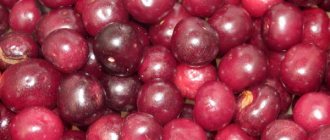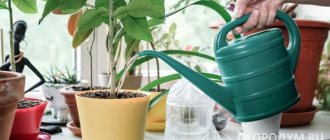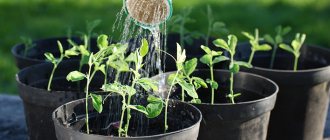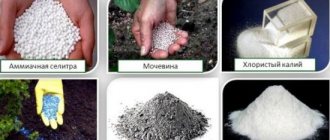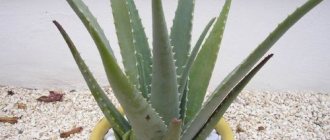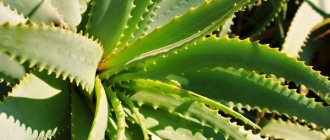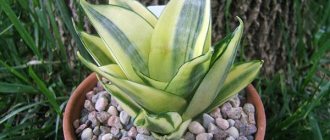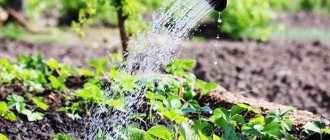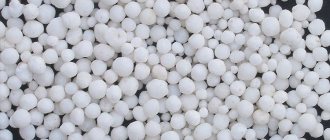To stimulate the growth and maintain the health of houseplants, most gardeners use aloe juice. Using this herbaceous perennial plant, you can prepare a highly effective fertilizer, which contains valuable microelements and vitamins. Aloe is a succulent plant that has more than five hundred species in its genus, the most common of which are: tree-like (“Aloe vera”) and true (“Agave”).
Why is it useful?
The juice of the perennial aloe vera triggers vital processes in the cells of other plants. This natural fertilizer has powerful bactericidal properties that protect plants from infection.
Potassium contained in the plant promotes the absorption of carbonic acids. Magnesium - regulates the process of photosynthesis. Thanks to aloe, the complex of physiological stages of plant life, including the development of the root system and flowering, proceeds more qualitatively and productively.
Japanese strawberries for 147 rubles for growing at home (advertising)
Chemical composition and benefits
The chemical composition of the plant is unique in its properties. It contains many substances:
- Acids: citric, hyaluronic, cinnamic, malic.
- Vitamins B, C and E.
- A large number of minerals: chromium, phosphorus, potassium, magnesium, iron, copper.
- Essential oils.
- Group of amino acids: valine, threonine, methionine.
- Fructose, glucose, uric acid, cellulose.
- Beta carotene.
- Catechins.
- Resinous substances 10%.
- Healthy fats.
Important. Aloe helps revitalize all life processes in cells.
- Natural fertilizer consists of antioxidants that protect plants from diseases.
- Potassium allows for better absorption of carbon dioxide.
- Magnesium is a good helper for photosynthesis. Flowering is stimulated and the root system develops better.
How is aloe used?
Aloe vera leaves, cut at the base, can be used to extract a gel with healing properties. The most practical use is to apply the gel directly to the skin, as it has a soothing and anti-inflammatory effect, as well as moisturizing and anti-aging.
If you wish, you can try your hand at making healthy drinks, carefully following reliable recipes, as well as creams, lotions and various detergents.
Cherkasov Daniil. Freelance writer
pharmachologic effect
Pharmacological action - general tonic, adaptogenic.
Aloe juice enhances bile secretion, the secretion of digestive glands, has a laxative effect and bactericidal activity against pathogens (internally), anti-inflammatory, wound-healing effect (externally).
Aloe syrup with iron contains easily digestible iron for the formation of hemoglobin and normal hematopoiesis, replenishes the lack of iron in the body associated with poor absorption in the gastrointestinal tract, blood loss, malnutrition, increased need for iron (pregnancy, active growth in children and adolescents).
Aloe liniment accelerates epithelization, increases skin tolerance to X-ray irradiation, has an analgesic effect, reduces burning sensation and tightness. In experiments on rabbits, it was found that when used prophylactically, it reduces the reaction and significantly shortens the healing time of radiation damage to the skin.
Aloe coated tablets are used as a biogenic stimulant.
What fertilizers are suitable for aloe?
Aloe, commonly known as agave, is a unique plant that is widely used not only in folk medicine, but also in traditional medicine and the cosmetics industry.
There are over 350 species of agave in nature. At the same time, only 2 varieties are suitable for medicinal purposes: vera and aloe vera. In this article we will talk about which fertilizer is best suited for growing aloe at home and other nuances of care.
Indications for the drug Aloe juice
Aloe juice: gastritis, gastroenteritis, enterocolitis, constipation (including spastic and atonic), chronic colitis (inside); acute and chronic purulent diseases (externally).
Aloe syrup with iron: anemia of various origins, iron deficiency in the body due to malabsorption, blood loss, malnutrition, increased need for iron (pregnancy, active growth of children and adolescents).
Aloe liniment: second and third degree burns, prevention and treatment of skin lesions during radiation therapy, dry and moist epidermatitis, kraurosis of the vulva, acute and subacute inflammatory processes (dermatitis, eczema, psoriasis, neurodermatitis, lichen planus) and other skin diseases.
Aloe coated tablets: myopic chorioretinitis, in the complex treatment of progressive myopia.
What flowers can be fed?
Attention. Houseplants come to life and breathe health after fertilizing from this succulent.
It will be especially useful to add fertilizer for young flowers that are just beginning to grow. If the plant is lethargic, its leaves are pale and too small, or growth has slowed down, then a nutrient solution is vital for them.
You need to be careful with violets. These flowers are very delicate and may not tolerate fertilizer well.
Can it be used as a fertilizer for vegetables and fruits?
The juice of this succulent is often used by gardeners in agriculture, watering seedlings with it. The plants soak the seeds of vegetables or fruits in the solution, after which they germinate well. It is useful to use fertilizer for the following crops:
- tomatoes;
- cabbage;
- radish;
- plum;
- eggplant;
- salad.
Do not soak celery, onion, feather, or pumpkin seeds in juice.
On our website there are other publications devoted to aloe juice, by reading which you can learn how to properly prepare it yourself and how to store it, as well as how and for what diseases it is used.
How and when to plant aloe
To start growing aloe vera, you rarely need to start from the seed itself. You can always buy the plant at the store, or if you have friends who already grow it, you can borrow a cutting from them. In fact, every cutting that grows from a mature plant can produce an adult plant if the necessary precautions are taken.
The best time for planting is spring, when the plant resumes vegetative activity. It is recommended to plant seedlings about 10 cm high.
You can replant your aloe plant directly outdoors in well-drained soil by adding mature compost or manure.
Features of growing aloe at home
Under natural conditions, agave grows in hot Africa. Plants for its processing are also located here. The stems are cut, washed, peeled and packed in sealed plastic bags. The resulting raw materials are sold to cosmetic and medical companies.
But for your own needs, it is quite possible to grow aloe at home. The main thing is to create comfortable conditions for the plant, as close as possible to natural ones: choose the right lighting and soil composition, ensure normal watering, temperature conditions and transplants as they grow, and regularly apply fertilizing.
Priming
Under natural conditions, like all succulents, agave grows in sandstones. Accordingly, at home it is important to prepare soil that is close in composition to the natural environment. Take 10% clay, 50% sand, 20% compost and humus each.
On a note! It is important to use fully ripened humus. To reduce ripening time, use a biological composting accelerator .
Mix all parts of the soil thoroughly and pour it into the pot on top of the drainage layer. When replanting the plant, carefully examine the roots, remove damaged parts and rub them with charcoal, remove the lower leaves and carefully replant the aloe into the pot.
Lighting and watering
In winter, the agave is in dire need of sunlight. Therefore, if there is not enough light in the apartment, for example, all windows face north, artificial lighting should be provided. In summer, on the contrary, too bright sunlight leads to “caking” of the plant. In order for aloe to gradually get used to too bright sun, take it out to the balcony (or veranda, if you live in a private house) in the spring. This should be done gradually: first for 15–20 minutes, then increase the time of “taking solar procedures.” Make sure that the plant is not exposed to rain.
Like all succulents, aloe reacts negatively to heavy watering and does not tolerate stagnant moisture. To prevent the roots of the plant from rotting, pour out the remaining water from the tray after watering. The recommended frequency of watering is once a week.
As for the temperature regime, aloe gets used to all conditions, but feels better in summer at temperatures of 20–26 ° C, and at lower temperatures in winter.
Can it be used as a top dressing?
Aloe juice is a healing agent. There are a number of advantages of using it as a plant food:
- no toxicity;
- good tolerance;
- environmental Safety;
- getting rid of bacteria;
- metabolism accelerates;
- not addictive.
You cannot use fresh aloe juice right away. The growth of the roots of the flower may stop, which will lead to its death.
Method for preparing an organic stimulant based on aloe juice
A natural growth stimulator for plants can be made independently and at home. To do this, it is recommended to use aloe juice directly. To prepare an organic stimulant, the first step is to cut off the leaves at the base of the aloe trunk. You can use both old sheets and very young ones.
It is necessary to note that old leaves contain more useful substances compared to young ones.
Then they should be wiped with a piece of cloth previously moistened with ordinary warm water, or rinsed under the tap. The sheets are placed in a bowl or pan.
Please note that the edges of the dishes must be high enough so that the liquid does not splash during operation. Using a masher or other suitable device, you need to thoroughly mash the sheets into a liquid, homogeneous paste. Next, take one glass of running water, add one tablespoon of the resulting mixture and mix everything well. The product is not ready yet; it needs to be covered with a lid and placed in a cool, dark room. After one week, the infusion is diluted with water to such a consistency that the resulting liquid is 5 liters. Before adding, the water should first be boiled and allowed to cool to room temperature.
Only now can you fertilize plant roots, cuttings, seeds and plant bulbs. The soaking time for bulbs, cuttings and plants is about 5 hours. After this, you can take them out and plant them directly in the ground; there is no need to rinse them with water. Over time, they will show excellent growth results.
